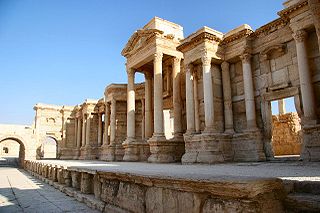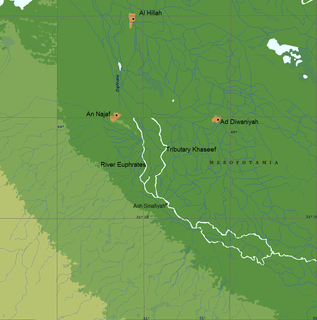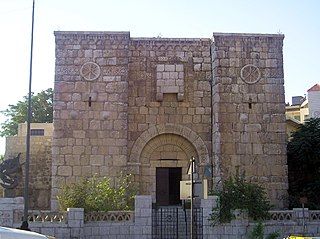The 630s decade ran from January 1, 630, to December 31, 639.

Year 633 (DCXXXIII) was a common year starting on Friday of the Julian calendar. The denomination 633 for this year has been used since the early medieval period, when the Anno Domini calendar era became the prevalent method in Europe for naming years.
The Battle of Yarmouk was a major battle between the army of the Byzantine Empire and the Muslim forces of the Rashidun Caliphate. The battle consisted of a series of engagements that lasted for six days in August 636, near the Yarmouk River, along what today are the borders of Syria–Jordan and Syria–Israel, east of the Sea of Galilee. The result of the battle was a complete Muslim victory which ended Byzantine rule in Syria. The Battle of Yarmouk is regarded as one of the most decisive battles in military history, and it marked the first great wave of early Muslim conquests after the death of the Prophet Muhammad, heralding the rapid advance of Islam into the then Christian Levant.

Al Anbar Governorate, or Anbar Province, is the largest governorate in Iraq by area. Encompassing much of the country's western territory, it shares borders with Syria, Jordan, and Saudi Arabia. The provincial capital is Ramadi; other important cities include Fallujah and Haditha.
The Battle of River also known as Battle of Al Madhar took place in Mesopotamia (Iraq) between the forces of the Rashidun Caliphate and the Sasanian Empire. Muslims, under Khalid ibn al-Walid's command, defeated the numerically superior Persian army.

The Battle of Walaja was a battle fought in Mesopotamia (Iraq) in May 633 between the Rashidun Caliphate army under Khalid ibn al-Walid and Al-Muthanna ibn Haritha against the Sassanid Empire and its Arab allies. In this battle the Sassanid army is said to have been at least three times the size of the Muslim army.
The Battle of Ayn al-Tamr took place in modern-day Iraq (Mesopotamia) between the early Muslim Arab forces and the Sassanians along with their Arab Christian auxiliary forces. Ayn al-Tamr is located west of Anbar and was a frontier post which had been established to aid the Sassanids.

Battle of Muzayyah was between the Muslim Arab army and the Sasanian Empire. When Khalid ibn Walid left from Ayn al-Tamr to Dumat Al-Jandal for the help of Iyad ibn Ghanm, the Persian court believed that Khalid had returned to Arabia with a large part of his army. The Persians decided to throw the Muslims back into the desert and regain the territories and the prestige which the Persian Empire had lost. The Persians had resolved not to fight Khalid again, but they were quite prepared to fight the Muslims without Khalid ibn al-Walid.

The battle of Zumail was fought in 633 CE in Mesopotamia. It was a major Muslim victory in their conquest of that area. Under cover of night the Arab Muslims attacked the Christian-Arab forces, loyal to the Sasanian Empire, from three different sides. The Christian-Arab forces were unable to withstand the Muslim's surprise attack and soon dispersed but failed to escape from the battlefield and became the victims of a three sided attack by Khalid ibn al-Walid's army. At Zumail nearly the whole Christian Arab army was slaughtered by Khalid's Corps.

The Battle of Firaz was the last battle of the Muslim Arab commander Khalid ibn al-Walid in Mesopotamia (Iraq) against the combined forces of the Byzantine Empire and the Sassanid Empire.

The Muslim conquest of the Levant or Arab conquest of the Levant occurred in the first half of the 7th century, and refers to the conquest of the region known as the Levant or Shaam, later to become the Islamic Province of Bilad al-Sham, as part of the Islamic conquests. Arab Muslim forces had appeared on the southern borders even before the death of prophet Muhammad in 632, resulting in the Battle of Mu'tah in 629, but the real invasion began in 634 under his successors, the Rashidun Caliphs Abu Bakr and Umar ibn Khattab, with Khalid ibn al-Walid as their most important military leader.

The Battle of Ullais was fought between the forces of the Rashidun Caliphate and the Sassanid Persian Empire in the middle of May 633 AD in Iraq, and is sometimes referred to as the Battle of Blood River since, as a result of the battle, there were enormous amounts of Sassanian and Arab Christian casualties.

The Battle of Hira was fought between the Sassanians and the Rashidun Caliphate in 633. It was one of the early battles of the Muslim conquest of Persia.

The Rashidun Caliphate was the first of the four major caliphates established after the death of the Islamic prophet Muhammad. It was ruled by the first four successive caliphs (successors) of Muhammad after his death in 632 CE. These caliphs are collectively known in Sunni Islam as the Rashidun, or "Rightly Guided" caliphs. This term is not used in Shia Islam as Shia Muslims do not consider the rule of the first three caliphs as legitimate.

The Siege of Damascus (634) lasted from 21 August to 19 September 634 AD before the city fell to the Rashidun Caliphate. Damascus was the first major city of the Byzantine (Roman) empire to fall in the Muslim conquest of Syria.

The Battle of Sallasil or the Battle of Chains was the first battle fought between the Rashidun Caliphate and the Sassanid Persian Empire. The battle was fought in Kuwait (Kazima) soon after the Ridda Wars were over and Eastern Arabia was united under the authority of Caliph Abu Bakr. It was also the first battle of the Rashidun Caliphate in which the Muslim army sought to extend its frontiers.
The Rashidun army was the core of the Rashidun Caliphate's armed forces during the Muslim conquests of the 7th century, serving alongside the Rashidun navy. The Rashidun army maintained a high level of discipline, strategic prowess and organization.

The Battle of al-Qādisiyyah, fought in 636, was a decisive battle between the Arab Muslim army and the army of the Sasanian Empire during the first period of Muslim conquests.
Qa'qa' ibn 'Amr ibn Malik al Tamimi was a man of Banu Tamim. He and his tribe converted to Islam possibly during the time of Ahnaf ibn Qais. He is known as successful Military Commander who took part in two important victorious battles in early Muslim Conquest, the Battle of Yarmouk against the Byzantine Empire and the Battle of al-Qādisiyyah against the Sassanian Empire which was led by Sa`d ibn Abi Waqqas. It was reported that in one time Caliph Abu Bakr praised him as an equal to eleven thousand men so in return the caliph predecessor, caliph Umar only sent him and a handful bodyguards as reinforcement to Al Qaddisiyah as the first wave as reinforcement. making him one of the most Illustrious military figures in that era.













